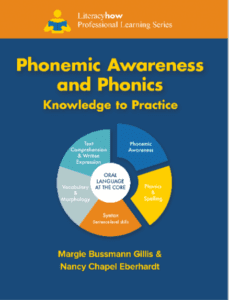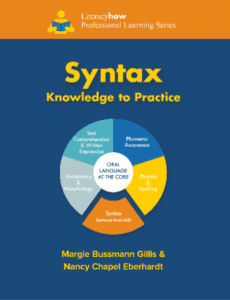
literacy how
professional learning Series
The Literacy How Professional Learning Series translates the latest reading research into how-to instruction. The Knowledge to Practice book Series—Phonemic Awareness and Phonics, Syntax, Vocabulary, and Comprehension—is based on the current and comprehensive Literacy How reading model. It draws upon the authors’ decades of expertise and experience working with thousands of general and special education teachers. Based on Chall’s Stages of Reading Development, the Series emphasizes Pre-K-3rd grade conceptual and skill development. Teachers of older emerging or struggling readers will also find these tools useful.
Each book contains relevant research, knowledge for effective instruction, activities for instruction and informal assessment, and text selection skills analysis.
“Everyone interested in understanding and guiding the reading development of children should be excited that
Gillis and Eberhardt are now making the deep knowledge and exemplary practices of Literacy How available to
us all in this book series.”
—Bob Cunningham, Advisor on Learning and Attention Issues to Understood.org and Noted Education Leader

Phonemic Awareness and Phonics
the keys to breaking the code!
Phonemic awareness and phonics—the two domains of literacy development essential for automatic word reading—are covered in Phonemic Awareness and Phonics: Knowledge to Practice. Related, but different, both domains are required for children to successfully learn to decode. Phonemic awareness, the realization that spoken words are made up of individual speech sounds (phonemes), provides the foundation for students to learn phonics. Phonics, the knowledge that these speech sounds are represented by letters (graphemes), provides the content and skill to access 85% of the words they need to read and spell. Empowered with this content and skills, beginning readers can acquire the code-breaking ability they need to unlock the printed word to become skilled readers.
User-friendly activities are organized by domains and sequenced by stages of reading development. This addition to the Literacy How Professional Learning Series will provide awesome professional development for teachers, administrators and Paraprofessionals.”
—Sheryl Ferlito, Ed.S., co-author, Sortegories; contributing writer, Language! & Language! Live; Special Education teacher/learning consultant

Syntax
is essential even for beginning readers!
Syntax, a linguist’s word for sentences, is foundational for reading comprehension and written expression. Understanding how sentences work—their components and structure—is the focus of Syntax: Knowledge to Practice. Building on their oral language abilities, beginning readers need to learn how sentence-level skills help them understand (i.e., comprehend) and create (i.e., compose) written language. Empowered with this ability, novice readers can move beyond their code-breaking skills to understand and appreciate what they read—the ultimate goal of reading.
“What Gillis and Eberhardt accomplish here is a rare feat. They blend a deep and complex understanding of the research concerning syntax with lessons teachers can immediately implement
in their classrooms.”
—William Van Cleave, W.V.C.ED, Educational Consultant and Author, Writing Matters

Vocabulary
is essential for effective comprehension!
Vocabulary, the body of words and their meanings that students must understand to comprehend text, is an essential component of literacy instruction. Vocabulary: Knowledge to Practice focuses on two interrelated dimensions of vocabulary instruction—word selection and instruction. The authors discuss a selection process emphasizing words worth teaching from reading selections. They also illustrate effective instructional practices including teaching words with multiple meanings, morphological elements, and content-based word networks. The goal—to help early readers expand the breadth and depth of their vocabulary knowledge.
“Vocabulary: Knowledge to Practice provides teachers with the principles of effective vocabulary instruction, along with specific activities for young learners. I’m delighted that Gillis and Eberhardt include early instruction of morphology, concentrating on bases, compound words, prefixes and suffixes.”
—Marcia K. Henry, Ph.D. Author, Unlocking Literacy: Effective Decoding and Spelling Instruction; former president, The International Dyslexia Association; Professor Emerita, San Jose State University

Comprehension
is the goal of reading—even for beginning readers!
Comprehension can’t wait for beginning readers to master decoding. Instruction that focuses on a variety of language processing abilities needs to occur concurrently with code-breaking instruction. Five big ideas shape our focus on reading comprehension instruction: text structure, background knowledge, text cohesion, inference, and the reading/writing connection. Each big idea emphasizes the development of students’ ability to understand text.
“Gillis and Eberhardt have written an incredible guide on comprehension that translates research into understandable language and builds connections to effective instructional practices.
Five big ideas initially emerge as essential to effective instruction; text structure, background knowledge, cohesion, inference, and the reading and writing connection. The authors describe the nature, development, cue questions with text examples and connection to comprehension for each. These provide a framework for thinking about informed instructional practice throughout this book.
I loved this window into [their] thinking and … perspective on instruction. The critical importance of the relationship between language systems and reading comprehension processes and skills is often misunderstood or overlooked. [Their] identification of the “big ideas’’ builds a bridge to this connection and captures so much of what is critical to making meaning. I particularly appreciated the inclusion of cohesion and the reading-writing connection!”
—Nancy Hennessey, Author, The Reading Comprehension Blueprint-Helping Students Making Meaning from Text